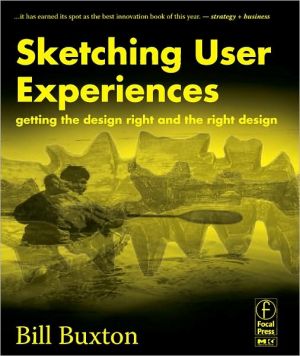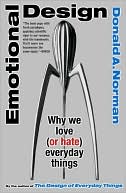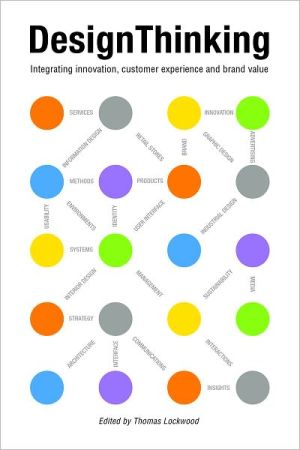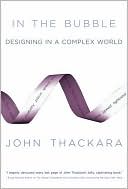Sketching User Experiences: Getting the Design Right and the Right Design
Bill Buxton and I share a common belief that design leadership together with technical leadership drives innovation. Sketching, prototyping, and design are essential parts of the process we use to create new products. Bill Buxton brings design leadership and creativity to Microsoft. Through his thought-provoking personal examples he is inspiring others to better understand the role of design in their own companies--Bill Gates, Chairman, Microsoft\ “Informed design is essential.” While it...
Search in google:
"Bill Buxton and I share a common belief that design leadership together with technical leadership drives innovation. Sketching, prototyping, and design are essential parts of the process we use to create new products. Bill Buxton brings design leadership and creativity to Microsoft. Through his thought-provoking personal examples he is inspiring others to better understand the role of design in their own companies."—Bill Gates, Chairman, Microsoft"Design is explained, with the means and manner for successes and failures illuminated by engaging stories, true examples and personal anecdotes. In Sketching User Experiences, Bill Buxton clarifies the processes and skills of design from sketching to experience modeling, in a lively and informative style that is rich with stories and full of his own heart and enthusiasm. At the start we are lost in mountain snows and northern seas, but by the end we are equipped with a deep understanding of the tools of creative design."—Bill Moggridge, Cofounder of IDEO and author of Designing Interactions“Informed design is essential.” While it might seem that Bill Buxton is exaggerating or kidding with this bold assertion, neither is the case. In an impeccably argued and sumptuously illustrated book, design star Buxton convinces us that design simply must be integrated into the heart of business."—Roger Martin, Dean, Rotman School of Management, University of Toronto"I love this book. There are very few resources available that see across and through all of the disciplines involved in developing great experiences. This is complex stuff and Buxton's work is both informed and insightful. He shares the work in an intimate manner that engages the reader and you will find yourself nodding with agreement, and smiling at the poignant relevance of his examples."—Alistair Hamilton, Symbol Technologies, NY“Like any secret society, the design community has its strange rituals and initiation procedures. Bill opens up the mysteries of the magical process of design, taking us through a land in which story-telling, orange squeezers, the Wizard of Oz, I-pods, avalanche avoidance, bicycle suspension sketching, and faking it are all points on the design pilgrim’s journey. There are lots of ideas and techniques in this book to feed good design and transform the way we think about creating useful stuff". —Peter GabrielThere is almost a fervor in the way that new products, with their rich and dynamic interfaces, are being released to the public—typically promising to make lives easier, solve the most difficult of problems, and maybe even make the world a better place. The reality is that few survive, much less deliver on their promise. The folly? An absence of design, and an over-reliance on technology alone as the solution.We need design. But design as described here depends on different skillsets—each essential, but on their own, none sufficient. In this rich ecology, designers are faced with new challenges—challenges that build on, rather than replace, existing skills and practice. Sketching User Experiences approaches design and design thinking as something distinct that needs to be better understood—by both designers and the people with whom they need to work— in order to achieve success with new products and systems. So while the focus is on design, the approach is holistic. Hence, the book speaks to designers, usability specialists, the HCI community, product managers, and business executives. There is an emphasis on balancing the back-end concern with usability and engineering excellence (getting the design right) with an up-front investment in sketching and ideation (getting the right design). Overall, the objective is to build the notion of informed design: molding emerging technology into a form that serves our society and reflects its values. Grounded in both practice and scientific research, Bill Buxton’s engaging work aims to spark the imagination while encouraging the use of new techniques, breathing new life into user experience design.• Covers sketching and early prototyping design methods suitable for dynamic product capabilities: cell phones that communicate with each other and other embedded systems, “smart” appliances, and things you only imagine in your dreams;• Thorough coverage of the design sketching method which helps easily build experience prototypes—without the effort of engineering prototypes which are difficult to abandon;• Reaches out to a range of designers, including user interface designers, industrial designers, software engineers, usability engineers, product managers, and others;• Full of case studies, examples, exercises, and projects, and access to video clips (www.mkp.com/sketching) that demonstrate the principles and methods.About the AuthorTrained as a musician, Bill Buxton began using computers over thirty years ago in his art. This early experience, both in the studio an on stage, helped develop a deep appreciation of both the positive and negative aspects of technology and its impact. This increasingly drew him into both design and research, with a very strong emphasis on interaction and the human aspects of technology. He first came to prominence for his work at the University of Toronto on digital musical instruments and the novel interfaces that they employed. This work in the late 70s gained the attention of Xerox PARC, where Buxton participated in pioneering work in collaborative work, interaction techniques and ubiquitous computing. He then went on to become Chief Scientist of SGI and Alias\|Wavefront, where he had the opportunity to work with some of the top film makers and industrial designers in the world. He is now a principal researcher at Microsoft Corp., where he splits his time between research and helping make design a fundamental pillar of the corporate culture.
Author's Note Preface PART I: DESIGN AS DREAMCATCHER Introduction Case Study: Apple, Design and Business The Bossy Rule A Snapshot of Today The Role of Design A Sketch of the Process The Cycle of Innovation The Question of ?Design?The Anatomy of Sketching Clarity is not always the Path to Enlightenment The Larger Family of Renderings Experience Design vs. Interface Design Sketching Interaction Sketches are not Prototypes Where is the User in all of this?You make that Sound like a Negative Thing If Someone Made a Sketch in the Forest and Nobody Saw it?The Object of Sharing Annotation: Sketching on Sketches Design Thinking & Ecology The Second Worst Thing that Can Happen A River Runs Through ItPART II: STORIES OF METHODS AND MADNESS Introduction The Wonderful Wizard of Oz Chameleon: From Wizardry to Smoke-and-Mirrors Le Bricolage: Cobbling Things Together It was a Dark and Stormy Night? Visual Story Telling Simple Animation Shoot the Mime Sketch-a-Move Extending Interaction: Real and Illusion The Bifocal Display Video Invisionment Interacting with Paper Are you Talking to me?PART III: RECAPITULATION & CODA Some Final ThoughtsPART IV: REFERENCES/BIBLIOGRAPHY
\ From Barnes & NobleThe Barnes & Noble Review\ Whatever you're designing -- software or toasters, microprocessors or skyscrapers -- you need to "put user experience front and center," says Bill Buxton. Here, Buxton makes a passionate case for a better way to design interactive products and the experiences surrounding them. The centerpiece is a technique humans have used successfully for centuries: sketching. \ Buxton, a trained musician and former chief scientist at SGI and Alias\|Wavefront, is now a principal researcher at Microsoft. He's deeply comfortable with all the skills that go into breakthrough design: He's capable of appreciating usability, engineering excellence, and profitability without losing sight of any of them.\ In Sketching User Experiences, he begins by assessing the current state of product and software design, good and bad. (There's a case study. Yes, it's Apple. But if you think there's nothing new to say about Apple, you're wrong: Buxton's found plenty.) Next, he explains why a real design process is so important, and what a good one might look like.\ Then, Buxton turns to sketching: design attempts that are quick, timely, inexpensive, disposable, plentiful, and fluid. Sketched designs "don't 'tell,' " he says, "they 'suggest.' " (Are you hearing echoes of some of the ideas organizations are pursuing to manage change more effectively, like agile development? If so, we agree.)\ Buxton gradually fleshes out his insights - for example, explaining how sketches and prototypes differ, and showing how to sketch interaction. Then, he returns to case studies: the working methods of some of the great designers he's encountered.\ They use many approaches and metaphors -- storytelling, flipbooks, bricolage, "video envisionment." Their assignments range from airline ticket kiosks to "the desk of the future." But each is here for a reason: to share hard-won, rarely discussed wisdom about the process of designing great products, interactions, and experiences. We've never seen anyone capture the field as well. Bill Camarda, from the June 2007 Read Only\ \ \ \ \ \ From the Publisher"Bill Buxton and I share a common belief that design leadership together with technical leadership drives innovation. Sketching, prototyping, and design are essential parts of the process we use to create new products. Bill Buxton brings design leadership and creativity to Microsoft. Through his thought-provoking personal examples he is inspiring others to better understand the role of design in their own companies."--Bill Gates, Chairman, Microsoft\ “Informed design is essential.” While it might seem that Bill Buxton is exaggerating or kidding with this bold assertion, neither is the case. In an impeccably argued and sumptuously illustrated book, design star Buxton convinces us that design simply must be integrated into the heart of business".--Roger Martin, Dean, Rotman School of Management, University of Toronto\ "Design is explained, with the means and manner for successes and failures illuminated by engaging stories, true examples and personal anecdotes. In Sketching User Experiences, Bill Buxton clarifies the processes and skills of design from sketching to experience modeling, in a lively and informative style that is rich with stories and full of his own heart and enthusiasm. At the start we are lost in mountain snows and northern seas, but by the end we are equipped with a deep understanding of the tools of creative design."--Bill Moggridge, Cofounder of IDEO and author of Designing Interactions\ "I love this book. There are very few resources available that see across and through all of the disciplines involved in developing great experiences. This is complex stuff and Buxton's work is both informed and insightful. He shares the work in an intimate manner that engages the reader and you will find yourself nodding with agreement, and smiling at the poignant relevance of his examples."--Alistair Hamilton, Symbol Technologies, NY\ "Like any secret society, the design community has its strange rituals and initiation procedures. Bill opens up the mysteries of the magical process of design, taking us through a land in which story telling, orange squeezers, the Wizard of oOz, I-pods, avalanche avoidance, bicycle suspension sketching, and faking it are all points on the design pilgrim’s journey. There are lots of ideas and techniques in this book to feed good design and transform the way we think about creating useful stuff. "\ --Peter Gabriel\ \ \







